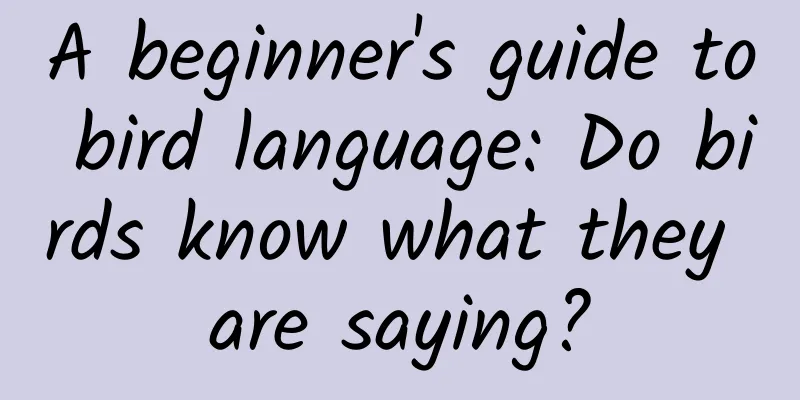A beginner's guide to bird language: Do birds know what they are saying?

|
© Knowable Magazine Leviathan Press: It is precisely because we have never found a way of information exchange that can be called human language in the non-human primates that are closest to us genetically that we regard language as a "symbol of civilization." It is also for this reason that bird language has attracted widespread attention for its language talent that surpasses that of non-human primates. The theory of evolution also follows Occam's razor. Birds' development of their own "language" may also be a result of demand-oriented. Although the capacity of birds' brains is small, it is inevitable that they develop language-related structural characteristics under demand-oriented conditions. After all, in comparison, primates including us have rich body language, and birds rely on sound to transmit information thanks to their sophisticated vocal structure. Except for flying mimics such as parrots and starlings, we have not yet found any animals that can learn to speak like humans. In our quest to understand what makes us uniquely human, we often compare ourselves to our closest relatives, the great apes. But when our search turns to one of the most classic human abilities, language, scientists are finding glimmering clues farther away. Vocal learning is a powerful gift that makes human language possible. Infants hear sounds and words, form memories, and then try to produce those sounds, strengthening this ability as they grow. In fact, most animals cannot imitate sounds. Although nonhuman primates can learn to make new sounds using their natural vocalization ability, they have not been seen to learn meaningful combinations of sounds. Interestingly, a few of our more distant mammalian relatives, such as dolphins and bats, do have this ability. Yet among the non-human speech learners scattered across the branches of the evolutionary tree of life, the most striking are birds—for them, it’s a piece of cake. Parrots, orioles, and hummingbirds can all learn new sounds. Some species in this group even have calls and songs that have a lot in common with human language, such as intentional communication and involving concepts in human language, such as phonetics, semantics, and simple syntax. The similarities don’t stop there, as they also have some brain structures similar to humans compared to species that don’t have the ability to learn sounds. “These consistencies have driven an explosion of research in the last 10 years,” says Julia Hyland Bruno, an animal behaviorist at Columbia University who studies the social aspects of song learning in zebra finches. “A lot of people are comparing bird song to human language.” Hyland-Bruno chose to study zebra finches because they are more social than most migratory birds. They migrate in small groups and occasionally join larger flocks. "I'm interested in how they learn these culturally transmitted vocalizations in these flocks," said Hyland-Bruno, who is a co-author of a 2021 article in the journal Annual Review of Linguistics, "Learning and Culture of Name Songs in Birds, with Comparisons to Human Language." (www.annualreviews.org/doi/10.1146/annurev-linguistics-090420-121034) Birdsong and human language are both passed down to the next generation through vocal learning. The songs of different geographically distant populations of the same bird species will deviate over time, eventually forming local differences - a process very similar to the different accents and dialects of human language. Knowing these similarities, it's logical to ask: Do birds have their own language? That probably depends on how you define language. “I wouldn’t say they have language as linguists would define it,” says neuroscientist Erich Jarvis of Rockefeller University in New York City, a co-author of Bruno’s paper on birdsong and human language. But for scientists like Jarvis, who study bird vocal communication in a neurobiological way, “I would say they have some fragmentary or primitive forms of what we might call verbal language.” Just like the word "love", when you ask people what it means you get different answers from different people. In a way there is no standard answer. "Verbal language has multiple components," Jarvis said, "and some components are possessed by more organisms than others." For example, a very common component is auditory learning. A dog can learn how to respond to the verbal command "sit." The vocal learning that humans and birds can do is a very special component, and of course other animals have this ability to some extent. (www.science.org/doi/abs/10.1126/science.aax0287) The grammar of bird language A key factor in human language is semantics - how words are connected to form meanings. In the past, scientists have always believed that, unlike human language, animal calls are involuntary behaviors that express emotions without conveying any information. However, in the past 40 years, a large number of studies have shown that quite a few animals can distinguish different meanings through different calls. Many birds use different calls to warn different predators. The Japanese tit, a bird that nests in tree holes, has a call that causes chicks to retreat into the nest to prevent crows from dragging them away, while another call causes chicks to simply jump out of the nest to avoid tree snakes. Siberian jays change their calls in response to the behavior of their natural predator, the hawk—perching, foraging, or actively attacking. Each call triggers a different response from the jays around them. Black-capped chickadees use the number of "beeps" in their calls to indicate the size and threat level of a predator. (www.sciencedirect.com/science/article/abs/pii/S0003347213004661) (www.sciencedirect.com/science/article/pii/S0960982207024189) (www.science.org/doi/10.1126/science.308.5730.1853a) Two recent studies have shown that the order of certain bird calls can have implications for meaning. Although there is still controversy, it is hypothesized that this could be the beginning of a set of rules governing how words or elements are combined — the syntax of human language. This classic example is often used to describe what word order and syntax are: dog bites man vs. man bites dog. In addition to warnings, many birds also use calls to call other members of the same species. The Far Eastern tit and the Southern pied babbler can combine the warning and calling calls of partners into a new call, which is used like an assembly call to summon accomplices to fight together and drive away predators. When the birds hear this call, they will approach the caller while scanning the enemy. (www.sciencedirect.com/science/article/pii/S0960982217307662) (www.pnas.org/content/113/21/5976.short) The order in which birdsong is combined makes sense to the Far Eastern chickadees, which may mean that they have the primitive prototypes of the word-order rules known as syntax in human languages. © SIGEKI/ADOBE STOCK The research team, led by animal behaviorist Toshitaka Suzuki from the University of Tokyo, found that for Far Eastern chickadees, the order of the calls is meaningful. When Suzuki's team played the "warning + call" combination to wild chickadees, they attracted far more chickadees than when they played the artificially reversed "call + warning" combination. Of course, can it be understood that this is simply because they only respond to the "warning + call" sequence they are used to, and do not actually distinguish the meaning of each part? In this regard, scientists have come up with a clever way to test this problem. Willow tits have their own calls to call their mates, and Far Eastern chickadees in the wild can also understand and respond to them. When Suzuki's team played the call of the willow tit and Far Eastern chickadees together, the Far Eastern chickadees showed the same response of listening to and approaching the speaker. Of course, the calls must be in the correct "warning + call" order. The results demonstrate a new commonality between animal communication systems and human language, Suzuki and colleagues wrote in a 2017 article in Current Biology. “But it’s not so easy to say whether these combinations of tit and thrush calls are analogous to human speech, which involves much more complex sequences,” says Adam Fishbein, a neuroscientist at the University of California, San Diego. “If they were something like language, you’d have a huge number of different combinations of calls. Birds have a very limited system.” Further exploration “I feel like people are imposing our own understanding of communication on birds,” says Fishbein, whose own research on zebra finch song suggests that syntax may not be as important to birds as it is to humans. © Smithsonian Magazine Bird songs can be very complex and tend to have typical sequences, patterns of notes, syllables, and motifs, so they are more like the human equivalent of language than the alarm calls of tits. To human ears, certain parts of bird songs are reminiscent of the syllables of words, so it's easy to assume that the order of these parts is important in conveying information. However, you might not realize that we don't actually know what these songs sound like to birds' ears. Fishbein's research shows that birds listen to songs in a completely different way than we do. All male zebra finches learn to hear the same "song," as sung over and over in this recording. Yet you'll still find a lot of variation between their individual performances. This presents another dimension of information for scientists to decipher. Recording: Juli Wade's lab, Michigan State University For his graduate thesis at the University of Maryland, Fishbein studied zebra finches, playing them sounds and training them to press a button when they heard a change in a sound. When the finches correctly identified the change in sound and pressed the button, they received a food reward. If they did it wrong, the lights around them would temporarily go out. Fishbein tested what kind of sound differences the birds could actually recognize, which could help scientists understand what aspects of birdsong are important to them. (royalsocietypublishing.org/doi/10.1098/rstb.2019.0044) In one test, Fishbein and his colleagues played grass finches a regular song recording over and over at regular intervals, then switched to a version in which some of the "syllables" were artificially shuffled. This change is easy to hear for humans, but surprisingly, birds are not good at recognizing the shuffled results. Yet birds outperformed humans in another test Fishbein gave them. Within each syllable of a bird song, there is a high-frequency detail called temporal fine structure, roughly equivalent to the timbre or pitch of a human voice. When the scientists disrupted the temporal fine structure of a bird song, for example by playing one syllable backwards, the chickadees were able to pick up on the change with extraordinary sensitivity. “This is a dimension of sound that they are much better at recognizing than we are,” Fishbein said. “They might be mining this for information that we don’t care about when we just listen to birdsong in general.” “Our understanding of what birds hear and what’s important to them is limited to what we can hear and — like a lot of science — the statistical parameters we use to parse birdsong,” said Juan Uriagereka, a linguist at the University of Maryland who collaborated with Fishbein. “Ten years ago we didn’t even know what the basic building blocks of their language were,” he said. “Obviously, the things we thought of as building blocks were just guesses, right?” Although all male zebra finches sing the same song, scientists have found that they derive many variations from the standard version with subtle differences in timing and structure. This means that birds should have a richer communication system than we previously suspected. "It is possible that most of the meaning is packed into a single element (for example, a fixed pitch change of a syllable may represent a complete sentence meaning)," Fishbein said, "and how these elements are arranged does not affect the meaning of the expression." Graphic translation: natural motif (original sequence); shuffled sequence (shuffled syllable sequence); syllable B reversed (reversed syllable B sequence); frequency. To investigate what aspects of zebra finches' songs are important to them, scientists scrambled a recording of a bird's song to see if the birds would notice. The top row is a spectrogram of a normal song. The middle row shows a recording where the scientists had shuffled the order of the syllables, which didn't catch the birds' attention. But when the scientists reversed one of the syllables, as shown in the bottom row, the birds picked it up easily. © ar FISHBEIN ET AL/PHILOSOPHICAL TRANSACTIONS OF THE ROYAL SOCIETY b 2019 You know what you're going to say Although some bird songs show rough similarities to aspects of human language, we still don't know what's actually going on in their brains. Most research on animal communication focuses on describing signals and behaviors - some of which may look similar to human behavior on the surface. But whether the underlying cognitive processes driving these behaviors are also the same is a big question. A key element of this question is intentionality. Are animals' behaviors purely a reaction to their environment, or are they really trying to convey something to their fellow birds? For example, when a bird finds food, it may make a specific call to attract other birds to come for food. Is this call just an unconscious exclamation of "Yeah! Food!", which objectively attracts other birds? Or is it really saying "Hey guys! Come and see the food I found!" Intentional signals exist in many animals. Ground squirrels, betta fish, chickens, and even fruit flies change their signals depending on who is around them, suggesting that they can consciously control their signals. Some animals can also intentionally show something to someone, such as a dog looking back and forth between its owner and a bag of food or hidden toys, and may even bark beforehand to get the person's attention. Crows will hold something in their beaks and show it to other crows (usually only when the other crow notices them). Some of the best recent evidence for intentional communication in birds comes from observations of wild Arabian babblers in Israel's Shezaf Nature Reserve. A team led by animal behaviorist Yitzchak Ben-Mocha documented adult babblers coaxing chicks to move to a new nest. The adults called and fluttered their wings in front of the chicks, then moved toward the nest. If the chicks didn't respond or fell behind, the adults would return and do the song and dance over and over again until the chicks caught up. (royalsocietypublishing.org/doi/10.1098/rspb.2019.0147) In this video, Arabian thrushes show that their communication has some meaning and intentionality, using calls and wingbeats to lure chicks to a new nest. Before walking straight to the nest, the thrush first signals to the chicks and checks if they are following, then turns back and repeats the signal. © Y. BEN MOCHA ET AL / ROYAL SOCIETY PROCEEDINGS B 2019 Scientists call this kind of signaling first-order intentional communication. Some researchers believe that the predecessors of our current language belong to second-order intentional communication. The difference is that the sender of the signal knows something about the receiver. Just like a bird that has found food knows that other birds have not found food and consciously wants to let them know. Of course, as you might guess, this kind of psychological activity is a difficult process to test. Other scientists are trying to understand the underlying mechanisms of this communication from another perspective - they are comparing the brain structures of singing birds capable of vocal learning and humans. Deep connection Although humans and birds are very distantly related in evolution—our most recent common ancestor is 300 million years old—we have very similar brain circuits for speech learning. Our closest relatives, nonhuman primates, lack this particular brain circuit, leading scientists to conclude that this ability did not come from a common ancestor but must have evolved independently. This is an example of convergent evolution. “There’s a common assumption that the closer a species is to us in evolution, the more similar it is to us. And that’s true in many ways,” said Rockefeller’s Jarvis. “But not in all ways.” Jarvis studies the evolution of language by looking at the brains of singing birds. Animals that can only make instinctive calls control the muscles that make those sounds through a circuit in the part of the brain stem near the spinal cord. Normally this area regulates automatic functions such as breathing and heartbeat. What happened in humans and singing birds, Jarvis said, is that a new circuit for learning sounds evolved in the forebrain and took over control of areas in the brainstem used for instinctive vocalization. His theory for how the speech-learning circuit evolved multiple times in different species is that it built on a neighboring circuit that controls learning certain movements. "The spoken language circuit in humans and the song-learning circuit in birds came from a complete duplication of the surrounding motor pathway." It's not clear how an entire brain circuit gets duplicated, Jarvis said. It's possible that just like certain gene segments sometimes get duplicated and selected for other uses, they just evolved that way. (royalsocietypublishing.org/doi/full/10.1098/rstb.2015.0056) The fact that speech-learning birds and humans share this rare but similar brain circuitry that allows them to learn and produce sounds means that the work of scientists trying to decipher human language by studying the communication behaviors of zebra finches, our evolutionarily distant relative, has major implications. "I think we humans have a tendency to exaggerate how unique we are," Jarvis said, despite observing how different the calls of zebra finches in the lab or the songs of starlings in the bushes seem to be from our own speech. "And here we are a year later with a discovery that shows how these circuits are connected, or how these mechanisms produce sound, and how similar these mechanisms are to the human brain." By Betsy Mason Translated by Hasutai Liu Proofreading/Sesame filling teeth gap Original article/knowablemagazine.org/article/mind/2022/do-birds-have-language This article is based on the Creative Commons License (BY-NC) and is published by Hasutai Liu on Leviathan The article only reflects the author's views and does not necessarily represent the position of Leviathan |
<<: Why do we love drinking boiled water?
>>: If we can harvest lightning, do we still need to generate electricity?
Recommend
Behind the prosperity of domestic mobile phone manufacturers is actually a bleak situation
In 2015 and 2016, the development of domestic mob...
From a scientific point of view, what exactly is "Tai Sui"?
Tai Sui has two meanings. "To disturb Tai Su...
How much does it cost to develop a Chifeng jewelry mini program? What is the price quote for Chifeng jewelry mini program customization?
How much does it cost to develop a jewelry mini p...
There are three levels of product marketing. Which one are you in?
I have also mentioned in previous articles that s...
Faith and the Cage, a documentary about Steve Jobs
[[149041]] “A churchman without empathy” That’s w...
Moto X 3rd generation high-end version review: balanced and cost-effective flagship
Motorola Mobility, a subsidiary of Lenovo, today ...
How to review an event you have organized? From which aspects?
This question comes from a reader's question,...
How much does it cost to create a prenatal education app in Xiangfan?
How much is the price for producing the Xiangfan ...
The traditional plum rain season has stopped, why is there no more mist and rain in the south of the Yangtze River?
For thousands of years, the plum rains have creat...
Is it harder to collect a prehistoric plant "puzzle" than to find "Dragon Balls" with a radar?
In the process of fossilization, it is difficult ...
4 key points and misunderstandings of refined operations in 2020
2020 is the year when online consumer demand has ...
The seemingly insignificant "invisible habit" is actually a kind of "zombie behavior"! ?
Leviathan Press: Getting up early and drinking a ...
6 marketing strategies that work well on the Internet and in physical stores, with 18 real cases included!
Without further ado, let’s get straight to the po...
A comprehensive analysis of Pinduoduo’s “Get Cash Every Day” campaign!
Regarding Pinduoduo 's "Get Cash Every D...
Zheng Xiangzhou-5 major business module system course complete version 6 episodes video
Zheng Xiangzhou - 5 major business module system ...









